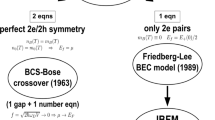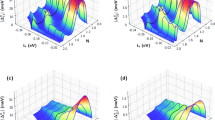Abstract
In part I of this paper a modified BCS mechanism of Cooper pair formation of electrons was proposed. This mechanism is connected with the existence of a narrow, roughly half-filled “superconducting energy band” of given symmetry. The special symmetry of the superconducting band was interpreted within a nonadiabatic extension of the Heisenberg model of magnetism. Within this nonadiabatic Heisenberg model, the electrons of the superconducting band are constrained to form Cooper pairs at zero temperature because in any normal conducting state the conservation of crystal-spin angular momentum would be violated. Except for this participation of the angular momentum, the pair formation is mediated in the familiar way by phonons. Superconducting bands can be identified even within a free-electron band structure. Therefore, in this paper the band structures of the bcc and hcp solid solution alloys composed of transition elements are approximated by appropriate free-electron band structures with s–d symmetry. From the free-electron bands, the number n of valence electrons per atom related to the maxima of the superconducting transition temperature T c in these solid solutions is calculated within the nonadiabatic Heisenberg model. The two observed maxima of T c are reproduced without any adjustable parameter at valence numbers n approximately equal to 4.9 and 6.5 in bcc and 4.7 and 6.7 in hcp solid solutions. This result is in good agreement with the measured values of 4.7 and 6.4 of Hulm and Blaugher. The upper maximum is predicted not to exist in bcc transition elements but to occur in several ordered structures of bcc solid solution alloys.
Similar content being viewed by others
REFERENCES
B. T. Matthias, Progress in Low Temperature Physics, Vol. 2, J. C. Gorter, ed. (North-Holland, Amsterdam, 1957).
J. K. Hulm and R. D. Blaugher, Phys. Rev. 123, 1569 (1966).
S. V. Vonsovsky, Y. A. Izyumov, and E. Z. Kurmaev, Superconductivity of Transition Metals (Springer, Berlin, 1982).
W. L. McMillan, Phys. Rev. 167, 331 (1968).
I. R. Gomersell and B. L. Gyorffy, Phys. Rev. Lett. 33, 1286 (1974).
C. M. Varma, E. I. Blount, P. Vashishta, and W. Weber, Phys. Rev. B 19, 6130 (1979).
E. Krüger, Phys. Rev. B 30, 2621 (1984).
E. Krüger, Phys. Rev. B 40, 11090 (1989).
E. Krüger, Phys. Rev. B 59, 13795 (1999).
E. Krüger, J. Supercond. 14(4), XXX (2001).
J. Bardeen, L. N. Cooper, and J. R. Schrieffer, Phys. Rev. 108, 1175 (1957).
E. Krüger, Phys. Status Solidi B 52, 215 (1972).
C. J. Bradley and A. P. Cracknell, The Mathematical Theory of Symmetry in Solids (Clarendon, Oxford, 1972).
L. F. Mattheis, Phys. Rev. B 1, 373 (1969).
J. C. Slater, Quantum Theory of Molecules and Solids, Vol. 2, (McGraw-Hill, New York, 1965).
E. Krüger, Phys. Status Solidi B 52, 519 (1972).
L. F. Mattheis, Phys. Rev. 151, 450 (1966).
R. J. Elliott, Phys. Rev. 96, 280 (1954).
E. Krüger, Phys. Status Solidi B 85, 493 (1978).
F. Ducastelle, Order and Phase Stability in Alloys (North-Holland, Amsterdam, 1991).
G. Bergman and D. P. Shoemaker, Acta Cryst. 7, 857 (1954); C. G. Wilson, Acta Cryst. 16, 724 (1962).
H.-W. Streitwolf, Gruppentheorie in der Festkörperphysik (Akademische Verlagsgesellschaft Geest & Portig KG, Leipzig, 1967).
E. Krüger, Phys. Status Solidi B 61, 193 (1974).
Author information
Authors and Affiliations
Rights and permissions
About this article
Cite this article
Krüger, E. Modified BCS Mechanism of Cooper Pair Formation in Narrow Energy Bands of Special Symmetry II. Matthias Rule Reconsidered. Journal of Superconductivity 14, 551–561 (2001). https://doi.org/10.1023/A:1012204126143
Issue Date:
DOI: https://doi.org/10.1023/A:1012204126143




